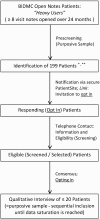Engaging patients through open notes: an evaluation using mixed methods
- PMID: 26826154
- PMCID: PMC4735137
- DOI: 10.1136/bmjopen-2015-010034
Engaging patients through open notes: an evaluation using mixed methods
Abstract
Objectives: (A) To gain insights into the experiences of patients invited to view their doctors' visit notes, with a focus on those who review multiple notes; (B) to examine the relationships among fully transparent electronic medical records and quality of care, the patient-doctor relationship, patient engagement, self-care, self-management skills and clinical outcomes.
Design: Mixed methods qualitative study: analyses of survey data, including content analysis of free-text answers, and quantitative-descriptive measures combined with semistructured individual interviews, patient activation measures, and member checks.
Setting: Greater Boston, USA.
Participants: Patients cared for by primary care physicians (PCPs) at the Beth Israel Deaconess Medical Center who had electronic access to their PCP visit notes. Among those submitting surveys, 576 free-text answers were identified and analysed (414 from female patients, 162 from male patients; 23-88 years). In addition, 13 patients (9 female, 4 male; 58-87 years) were interviewed.
Results: Patient experiences indicate improved understanding (of health information), better relationships (with doctors), better quality (adherence and compliance; keeping track) and improved self-care (patient-centredness, empowerment). Patients want more doctors to offer access to their notes, and some wish to contribute to their generation. Those patients with repeated experience reviewing notes express fewer concerns and more perceived benefits.
Conclusions: As the use of fully transparent medical records spreads, it is important to gain a deeper understanding of possible benefits or harms, and to characterise target populations that may require varying modes of delivery. Patient desires for expansion of this practice extend to specialty care and settings beyond the physician's office. Patients are also interested in becoming involved actively in the generation of their medical records. The OpenNotes movement may increase patient activation and engagement in important ways.
Keywords: GENERAL MEDICINE (see Internal Medicine); PRIMARY CARE; Patient Activation; QUALITATIVE RESEARCH; Self-Care.
Published by the BMJ Publishing Group Limited. For permission to use (where not already granted under a licence) please go to http://www.bmj.com/company/products-services/rights-and-licensing/
Figures





References
-
- Ridsdale L, Hudd S. What do patients want and not want to see about themselves on the computer screen: a qualitative study. Scan J Prim Health Care 1997;15:180–3. - PubMed
-
- Michael M, Bordley C. Do patients want access to their medical records? Med Care 1982;20:432–5. - PubMed
-
- Delbanco T, Walker J. Patients should have easier access to their doctors’ medical notes. Mod Healthc 2011;41:22. - PubMed
MeSH terms
LinkOut - more resources
Full Text Sources
Other Literature Sources
Research Materials
